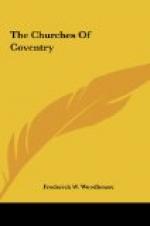...left his sheep encumbered in the mire,
And ran unto London, unto Saint Foul’s,
To seeke him a chantery for souls.
The number of chantries in the different cathedrals varied very greatly, Lichfield had eighty-seven, St. Paul’s thirty-seven, York only three. Monks’ churches had few or none while in town churches they were numerous, London having one hundred and eighty, York forty-two, Coventry at least fifteen besides the twelve gild priests of the chapel of Babelake. Most were founded in connection with an existing altar, some had a special altar, at Winchester, Tewkesbury and elsewhere they were enclosed in screens between the pillars of the nave, or a special chapel was added to the church.
It was in the thirteenth century also (1267) that the monastery obtained the grant of a Merchants’ Gild; with all the privileges thereto belonging, the earliest of those which contributed so much to the renown of Coventry. These were Benefit Societies, insuring help to the “Brethren and sistren” in old age, sickness or poverty, securing to them the services of the church after death and in all cases established on a strictly religious basis and placed under the protection of a Saint, or of the Holy Trinity. The regulation and protection of trade interests, generally aiming at monopoly and the exclusion of outsiders, were later developments. But without doubt they were public-spirited bodies according to their lights, maintaining schools (as at Stratford-on-Avon) hospitals and almshouses, and giving freely on all occasions of public importance. By pageants too, they contributed to the happiness and amusement of the people as well as by the presentation of Mysteries and Moralities, to their instruction and edification. But in the eyes of the Reformers, or of grasping courtiers, all this went for nothing when weighed against the heinous offence of supporting chaplains to pray for deceased members and so (6 Edward VI) they were suppressed along with the chantries, and their property confiscated, “the very meanest and most inexcusable of the plunderings which threw discredit on the Reformation.”
Here, the city bought back everything which had belonged to the Trinity and Corpus Christi Gilds, with various almshouses and the possessions of the majority of the Chantries; while previously at the Dissolution it had bought the abbey-orchard, and mill, and the house and church of the Grey Friars.
In 1340 Edward III granted Licence to the Coventry men to form a Merchants’ Gild with leave “to make chantries, bestow alms, do other works of piety and constitute ordinances touching the same.” This was St. Mary’s Gild. Two years later that of St. John Baptist was formed and a year later that of St. Katherine, the three being united into the Trinity Gild before 1359. Of the chapel (now St. John’s church) begun in 1344 by the St. John’s Gild and the “fair and stately structure for their feasts and meetings called St Mary




